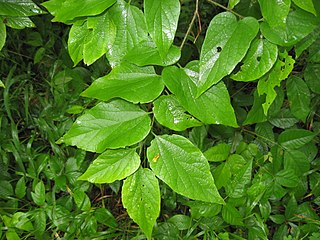
Celtis tenuifolia, the dwarf hackberry or Georgia hackberry is a shrub or small tree 2-to-12-metre-high. It is native to eastern North America but is very uncommon north of the Ohio River. In Canada, dwarf hackberry is designated as threatened and protected under Canada's Species at Risk Act.
The Species at Risk Act is a piece of Canadian federal legislation which became law in Canada on December 12, 2002. It is designed to meet one of Canada's key commitments under the International Convention on Biological Diversity. The goal of the Act is to prevent wildlife species in Canada from disappearing by protecting endangered or threatened organisms and their habitats. It also manages species which are not yet threatened, but whose existence or habitat is in jeopardy.
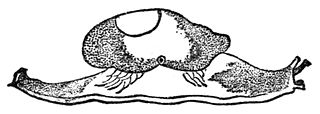
Hemphillia is a genus of air-breathing land slugs, terrestrial pulmonate gastropod mollusks in the family Binneyidae.

Gonidea angulata, the western ridged mussel or Rocky Mountain ridged mussel, is a species of freshwater mussel, an aquatic bivalve mollusk in the family Unionidae, the river mussels. It is the only species in the genus Gonidea.

The bigmouth shiner, is one of the 324 fish species found in Tennessee. It is a common minnow species found in the midwest region, but found as far as the east coast. There has been little information researched about this minnow outside of the general body plan and habitat. They are often found along with common shiner in streams.
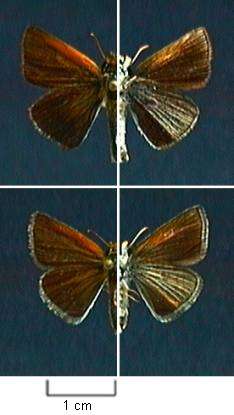
Oarisma poweshiek, the Poweshiek skipperling, is a North American butterfly in the family Hesperiidae (skippers), subfamily Hesperiinae. The range of this species in Canada is restricted to southeastern Manitoba, and in the United States it historically ranged from the Dakotas to the southern Lower Peninsula of Michigan.
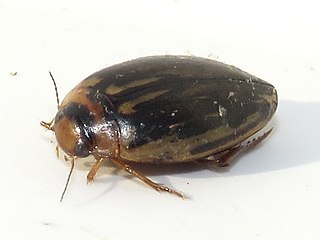
Coptotomus is a genus of predaceous diving beetles in the family Dytiscidae, the only genus of the subfamily Coptotominae. There are about six described species in Coptotomus, found in North America and the Neotropics.

Dolphin and Union Caribou, Dolphin and Union caribou herd, Dolphin-Union, locally known as Island Caribou, are a migratory population of barren-ground caribou, Rangifer tarandus groenlandicus, that occupy Victoria Island in the Canadian Arctic Archipelago and the nearby mainland. They are endemic to Canada. They migrate across the Dolphin and Union Strait from their summer grazing on Victoria Island to their winter grazing area on the Nunavut-Northwest Territories mainland in Canada. It is unusual for North American caribou to seasonally cross sea ice and the only other caribou to do so are the Peary caribou who are smaller in size and population. They were listed as Endangered by Committee on the Status of Endangered Wildlife in Canada (COSEWIC) since November 2017.
Agabetes acuductus is a species of predaceous diving beetle found in the United States and Canada. Its habitat includes wooded wetlands, in the leaf litter of shaded pools, and cattail ponds.
Agabus obliteratus is a species in the family Dytiscidae, in the order Coleoptera ("beetles"). It is found in North America.
Sanfilippodytes compertus is a species of predaceous diving beetles in the family Dytiscidae. It is found in North America.
Hygrotus sayi is a species of predaceous diving beetle in the family Dytiscidae. It is found in North America.
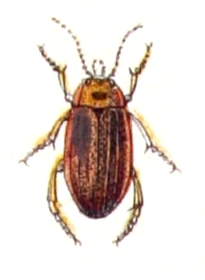
Rhantus frontalis is a species of predaceous diving beetle in the family Dytiscidae. It is found in Europe and Northern Asia and North America.
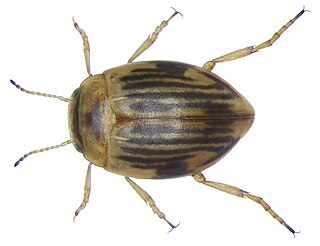
Oreodytes sanmarkii is a species of predaceous diving beetle in the family Dytiscidae. It has a holarctic distribution, found in aquatic habitats in Europe, northern Asia, and North America. It has an affinity toward low-velocity currents and pebbly microhabitat substrates. It was described by Finnish entomologist Carl Reinhold Sahlberg in 1826.

Argia vivida, the vivid dancer, is a species of narrow-winged damselfly in the family Coenagrionidae. This species is commonly found in springs and forests Central America and North America. Argia vivida inhabit areas of diverse temperatures due to thermoregulation. The species is also considered the state insect of Nevada.
Sanfilippodytes edwardsi is a species of predaceous diving beetle in the family Dytiscidae. It's found in North America.

Dytiscus habilis is a species of predaceous diving beetle in the family Dytiscidae. It is found in North America from Oklahoma to Arizona south throughout Mexico to Guatemala; it is the only Dytiscus species found in the Neotropics.
Etruscodytes is a genus of predaceous diving beetles in the family Dytiscidae. There is one described species in Etruscodytes, E. nethuns, found in the Palearctic.
Spanglerodessus is a genus of predaceous diving beetles in the family Dytiscidae. There is one described species in Spanglerodessus, S. shorti. They are found in the Neotropics.

Peltigera gowardii, or western waterfan, is an aquatic lichen found only in mountain streams of Western North America. It is the largest aquatic lichen in the Pacific Northwest.











